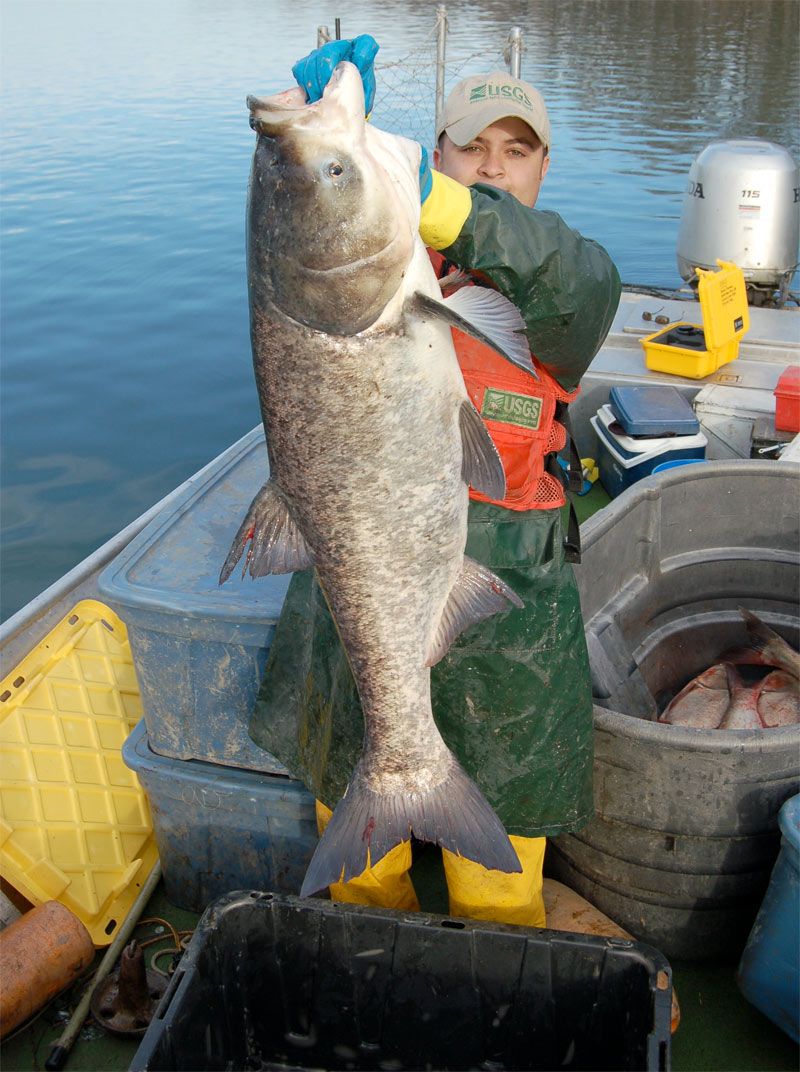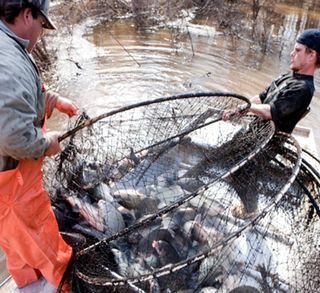Flood Fears: Ferocious Alien Fish Will Spread into New Areas

The flooding in the south last month may be just what a ferocious fish ordered, as scientists say the overflowing Mississippi River may lead to a surge in the giant invasive fish called the Asian carp in new areas of the Mississippi and Missouri river basins.
The flooding stretched from the Midwest to the Gulf of Mexico covering 6.5 million acres of land. This water could serve as a throughway connecting the Mississippi and Missouri rivers to other lakes, bayous and marshes in the basin. The young fish, which float downstream before making their homes in a quiet "nursery," could ride these waters to other, not normally connected bodies of water.
"These fish do really well in a flood situation, it gives their young very good quality nursing habitat. Floods induce the fish to spawn," Duane Chapman at the U.S. Geological Survey, told LiveScience. "It should be a good year for reproduction and a lot of young will get trapped up on the floodplain."
Some of these new stretches may not be suitable for the invasive fish, while others may be just right, researchers say. But once the invasive fish bustle into an environment, they're usually there to stay, eating other fish out of house and home with their voracious appetite. A single Asian carp — weighing up to a whopping 100 pounds (45 kilograms) — can scarf down 5 to 10 percent of its body weight a day in plankton. [Read: 10 Scariest Sea Creatures]
In fact, they have already done damage in the Illinois River and threaten the Great Lakes. The fish's high rates of reproduction and insatiable appetite end up outcompeting native species in these areas. Their populations get so high they can be seen jumping out of the water behind boats, sometimes landing in the boat and hitting a person.

Footloose on the floodplain
Native to Southeast Asia and China, the various Asian carp, including the silver and bighead species, were introduced to the Mississippi and Missouri River basins starting in the 1960s during floods, which caused the overflow of catfish aquaculture ponds where the carp were being kept for their ability to keep algae at bay.
Sign up for the Live Science daily newsletter now
Get the world’s most fascinating discoveries delivered straight to your inbox.
They've made their home in the Mississippi and Missouri rivers and have so far maintained a low population levels. The flooding to lead to an explosion of the population and the fish could spread to new areas, including currently uninhabited tributaries and lakes.
Now, the question on the minds of conservationists and others is: Will the carp survive in these new habitats? The fish are hearty, but low dissolved oxygen or warmer waters could make some of these new habitats unlivable.
"It's reasonable to assume that they are being moved around because there's all that water going through, but it's difficult to know if after they are moved they will thrive," Mike Kaller, at Louisiana State University, told LiveScience.
Similar flooding in 2008 didn't show this grand expansion of the carps' range, Kaller said, though this time around the waters are flowing through the open spillway, which could expand the population into Lake Pontchartrain and Lake Maurepas. A major flood in 1993 did end up increasing carp populations, though, said Chapman.
Reproductive impairment
Even if the fish do survive in these habitats, many of them won't be suitable for reproduction, which requires a swiftly moving water source to carry the eggs and larvae downstream. The fish can live for up to 25 years, though, especially in an area with few predators. Even if they can't reproduce, they will still wreak havoc on the ecosystems for a long time.
"In those bodies of water they won't spawn, but they will grow up in there. They can live 25 years, so there will be carp in those lakes for a long time," Chapman said. "They will compete with the native fishes, if there is a shortage of food."
Mark Pegg, at the University of Nebraska, notes that the floods will take several months to fully recede, giving the fish enough time to find their way back to the river when the water starts getting low. Because they will have access to all of these new habitats, however, the population will most likely increase starkly. If these fish make it back to the rivers as the floodwater recedes, the overpopulation will be tremendous, he said.
"On the Missouri they are talking about sustained high water through the summer, the backwaters will be open to them for a pretty long period of time, my guess is that a pretty substantial number would make it back," Pegg told LiveScience. "That may not be the case on the Mississippi, once the water goes down the fish will probably be trapped."
The carp aren't the only ones hitching a ride on the floodwaters. Native species are spread the same way, and the flood will give them access to new habitats as well. "They might also have a good reproductive year," Pegg said. "Maybe they can eat some of the small Asian carp before they get too big. Might help control some of the non-native population."
@font-face { font-family: "Arial"; }@font-face { font-family: "Calibri"; }@font-face { font-family: "Lucida Console"; }p.MsoNormal, li.MsoNormal, div.MsoNormal { margin: 12pt 0in 3pt; line-height: 115%; font-size: 10pt; font-family: Helvetica; }div.Section1 { page: Section1; }
You can follow LiveScience staff writer Jennifer Welsh on Twitter @microbelover. Follow LiveScience for the latest in science news and discoveries on Twitter @livescience and on Facebook.
Jennifer Welsh is a Connecticut-based science writer and editor and a regular contributor to Live Science. She also has several years of bench work in cancer research and anti-viral drug discovery under her belt. She has previously written for Science News, VerywellHealth, The Scientist, Discover Magazine, WIRED Science, and Business Insider.










